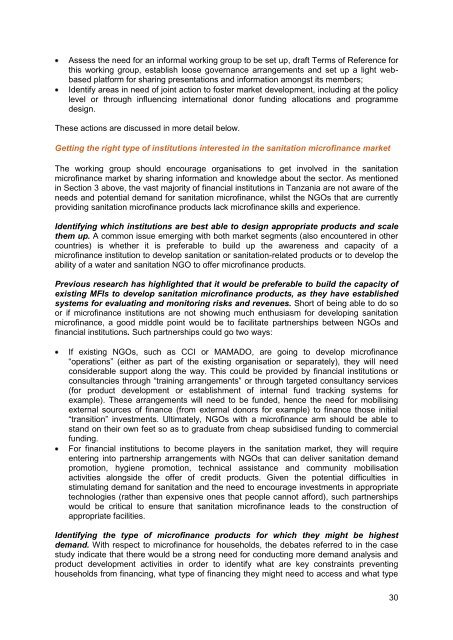REPORT__Evaluating_the_potential_of_microfinance_for_sanitation_in_Tanzania_May_2013
REPORT__Evaluating_the_potential_of_microfinance_for_sanitation_in_Tanzania_May_2013
REPORT__Evaluating_the_potential_of_microfinance_for_sanitation_in_Tanzania_May_2013
Create successful ePaper yourself
Turn your PDF publications into a flip-book with our unique Google optimized e-Paper software.
Assess <strong>the</strong> need <strong>for</strong> an <strong>in</strong><strong>for</strong>mal work<strong>in</strong>g group to be set up, draft Terms <strong>of</strong> Reference <strong>for</strong><br />
this work<strong>in</strong>g group, establish loose governance arrangements and set up a light webbased<br />
plat<strong>for</strong>m <strong>for</strong> shar<strong>in</strong>g presentations and <strong>in</strong><strong>for</strong>mation amongst its members;<br />
Identify areas <strong>in</strong> need <strong>of</strong> jo<strong>in</strong>t action to foster market development, <strong>in</strong>clud<strong>in</strong>g at <strong>the</strong> policy<br />
level or through <strong>in</strong>fluenc<strong>in</strong>g <strong>in</strong>ternational donor fund<strong>in</strong>g allocations and programme<br />
design.<br />
These actions are discussed <strong>in</strong> more detail below.<br />
Gett<strong>in</strong>g <strong>the</strong> right type <strong>of</strong> <strong>in</strong>stitutions <strong>in</strong>terested <strong>in</strong> <strong>the</strong> <strong>sanitation</strong> micr<strong>of</strong><strong>in</strong>ance market<br />
The work<strong>in</strong>g group should encourage organisations to get <strong>in</strong>volved <strong>in</strong> <strong>the</strong> <strong>sanitation</strong><br />
micr<strong>of</strong><strong>in</strong>ance market by shar<strong>in</strong>g <strong>in</strong><strong>for</strong>mation and knowledge about <strong>the</strong> sector. As mentioned<br />
<strong>in</strong> Section 3 above, <strong>the</strong> vast majority <strong>of</strong> f<strong>in</strong>ancial <strong>in</strong>stitutions <strong>in</strong> <strong>Tanzania</strong> are not aware <strong>of</strong> <strong>the</strong><br />
needs and <strong>potential</strong> demand <strong>for</strong> <strong>sanitation</strong> micr<strong>of</strong><strong>in</strong>ance, whilst <strong>the</strong> NGOs that are currently<br />
provid<strong>in</strong>g <strong>sanitation</strong> micr<strong>of</strong><strong>in</strong>ance products lack micr<strong>of</strong><strong>in</strong>ance skills and experience.<br />
Identify<strong>in</strong>g which <strong>in</strong>stitutions are best able to design appropriate products and scale<br />
<strong>the</strong>m up. A common issue emerg<strong>in</strong>g with both market segments (also encountered <strong>in</strong> o<strong>the</strong>r<br />
countries) is whe<strong>the</strong>r it is preferable to build up <strong>the</strong> awareness and capacity <strong>of</strong> a<br />
micr<strong>of</strong><strong>in</strong>ance <strong>in</strong>stitution to develop <strong>sanitation</strong> or <strong>sanitation</strong>-related products or to develop <strong>the</strong><br />
ability <strong>of</strong> a water and <strong>sanitation</strong> NGO to <strong>of</strong>fer micr<strong>of</strong><strong>in</strong>ance products.<br />
Previous research has highlighted that it would be preferable to build <strong>the</strong> capacity <strong>of</strong><br />
exist<strong>in</strong>g MFIs to develop <strong>sanitation</strong> micr<strong>of</strong><strong>in</strong>ance products, as <strong>the</strong>y have established<br />
systems <strong>for</strong> evaluat<strong>in</strong>g and monitor<strong>in</strong>g risks and revenues. Short <strong>of</strong> be<strong>in</strong>g able to do so<br />
or if micr<strong>of</strong><strong>in</strong>ance <strong>in</strong>stitutions are not show<strong>in</strong>g much enthusiasm <strong>for</strong> develop<strong>in</strong>g <strong>sanitation</strong><br />
micr<strong>of</strong><strong>in</strong>ance, a good middle po<strong>in</strong>t would be to facilitate partnerships between NGOs and<br />
f<strong>in</strong>ancial <strong>in</strong>stitutions. Such partnerships could go two ways:<br />
If exist<strong>in</strong>g NGOs, such as CCI or MAMADO, are go<strong>in</strong>g to develop micr<strong>of</strong><strong>in</strong>ance<br />
“operations” (ei<strong>the</strong>r as part <strong>of</strong> <strong>the</strong> exist<strong>in</strong>g organisation or separately), <strong>the</strong>y will need<br />
considerable support along <strong>the</strong> way. This could be provided by f<strong>in</strong>ancial <strong>in</strong>stitutions or<br />
consultancies through “tra<strong>in</strong><strong>in</strong>g arrangements” or through targeted consultancy services<br />
(<strong>for</strong> product development or establishment <strong>of</strong> <strong>in</strong>ternal fund track<strong>in</strong>g systems <strong>for</strong><br />
example). These arrangements will need to be funded, hence <strong>the</strong> need <strong>for</strong> mobilis<strong>in</strong>g<br />
external sources <strong>of</strong> f<strong>in</strong>ance (from external donors <strong>for</strong> example) to f<strong>in</strong>ance those <strong>in</strong>itial<br />
“transition” <strong>in</strong>vestments. Ultimately, NGOs with a micr<strong>of</strong><strong>in</strong>ance arm should be able to<br />
stand on <strong>the</strong>ir own feet so as to graduate from cheap subsidised fund<strong>in</strong>g to commercial<br />
fund<strong>in</strong>g.<br />
For f<strong>in</strong>ancial <strong>in</strong>stitutions to become players <strong>in</strong> <strong>the</strong> <strong>sanitation</strong> market, <strong>the</strong>y will require<br />
enter<strong>in</strong>g <strong>in</strong>to partnership arrangements with NGOs that can deliver <strong>sanitation</strong> demand<br />
promotion, hygiene promotion, technical assistance and community mobilisation<br />
activities alongside <strong>the</strong> <strong>of</strong>fer <strong>of</strong> credit products. Given <strong>the</strong> <strong>potential</strong> difficulties <strong>in</strong><br />
stimulat<strong>in</strong>g demand <strong>for</strong> <strong>sanitation</strong> and <strong>the</strong> need to encourage <strong>in</strong>vestments <strong>in</strong> appropriate<br />
technologies (ra<strong>the</strong>r than expensive ones that people cannot af<strong>for</strong>d), such partnerships<br />
would be critical to ensure that <strong>sanitation</strong> micr<strong>of</strong><strong>in</strong>ance leads to <strong>the</strong> construction <strong>of</strong><br />
appropriate facilities.<br />
Identify<strong>in</strong>g <strong>the</strong> type <strong>of</strong> micr<strong>of</strong><strong>in</strong>ance products <strong>for</strong> which <strong>the</strong>y might be highest<br />
demand. With respect to micr<strong>of</strong><strong>in</strong>ance <strong>for</strong> households, <strong>the</strong> debates referred to <strong>in</strong> <strong>the</strong> case<br />
study <strong>in</strong>dicate that <strong>the</strong>re would be a strong need <strong>for</strong> conduct<strong>in</strong>g more demand analysis and<br />
product development activities <strong>in</strong> order to identify what are key constra<strong>in</strong>ts prevent<strong>in</strong>g<br />
households from f<strong>in</strong>anc<strong>in</strong>g, what type <strong>of</strong> f<strong>in</strong>anc<strong>in</strong>g <strong>the</strong>y might need to access and what type<br />
30


